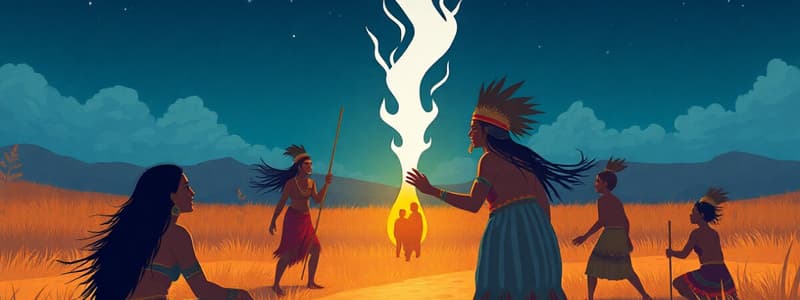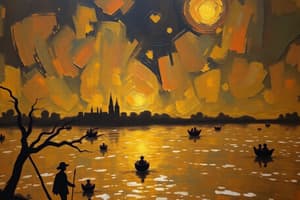Podcast
Questions and Answers
Match the following Native American artworks influences with their descriptions:
Match the following Native American artworks influences with their descriptions:
European materials = Used in their work European events = Portrayed in Native historical contexts European traditions = Adapted while retaining Native imagery Artistic techniques = Experimented with contrapposto and chiaroscuro
Match the sites with their notable features:
Match the sites with their notable features:
Chavín de Huántar = Comb roof Templo Mayor = Ceremonial center Mesa Verde cliff dwellings = Subterranean rooms Yaxchilán = Corbeled arch design
Match the techniques or materials with their corresponding artworks or sites:
Match the techniques or materials with their corresponding artworks or sites:
Ashlar masonry = Machu Picchu Hammered metal sheets = The Maize Cob Kivas = Subterranean rooms at Cliff Place European styles = Adapted in Native American art
Match the terms with their definitions or uses:
Match the terms with their definitions or uses:
Match the civilizations with their corresponding time periods:
Match the civilizations with their corresponding time periods:
Match the structure designs with their types:
Match the structure designs with their types:
Match the features with the corresponding cultural significance:
Match the features with the corresponding cultural significance:
Match the artists or painters with their respective pieces or contributions:
Match the artists or painters with their respective pieces or contributions:
Match the following artworks or archaeological findings with their descriptions:
Match the following artworks or archaeological findings with their descriptions:
Match the following terms with their meanings:
Match the following terms with their meanings:
Match the following individuals or groups with their contributions:
Match the following individuals or groups with their contributions:
Match the following tribes with their notable characteristics:
Match the following tribes with their notable characteristics:
Match the following archaeological sites with their historical significance:
Match the following archaeological sites with their historical significance:
Match the following rituals with their elements:
Match the following rituals with their elements:
Match the following civilizations with their historical aspects:
Match the following civilizations with their historical aspects:
Match the following expressions with their implications:
Match the following expressions with their implications:
Match the following terms related to the potlatch ceremony:
Match the following terms related to the potlatch ceremony:
Match the stories of the Lanzon Stone and the Great Serpent Mound:
Match the stories of the Lanzon Stone and the Great Serpent Mound:
Match the following statements about the Feathered Headdress and Machu Picchu structures:
Match the following statements about the Feathered Headdress and Machu Picchu structures:
Match the styles associated with Bandolier bags and tribes:
Match the styles associated with Bandolier bags and tribes:
Match the statements regarding the designs and uses of bandolier bags:
Match the statements regarding the designs and uses of bandolier bags:
Match the characteristics of the Kwakwaka'wakw transformation mask with their description:
Match the characteristics of the Kwakwaka'wakw transformation mask with their description:
Match the false statements to their correct statements:
Match the false statements to their correct statements:
Match the elements of the ceremonial context to their corresponding meanings:
Match the elements of the ceremonial context to their corresponding meanings:
Flashcards
Applied Art
Applied Art
Art that is designed to have a practical purpose, often for everyday use or functionality. This could include pottery, weaving, jewelry, tools, or decorative objects
Performance Art
Performance Art
Art that involves the artist's body and performance, focusing on the process and experience rather than a static object. This can include actions, gestures, and interactions with the audience.
Māori Culture
Māori Culture
The Māori culture of New Zealand, known for its intricate carving and tattooing traditions.
Comb Roof
Comb Roof
Signup and view all the flashcards
Kiva
Kiva
Signup and view all the flashcards
Ashlar Masonry
Ashlar Masonry
Signup and view all the flashcards
Corbeled Arch
Corbeled Arch
Signup and view all the flashcards
Chavín Civilization
Chavín Civilization
Signup and view all the flashcards
What is the Intihuantana Stone?
What is the Intihuantana Stone?
Signup and view all the flashcards
What is the Painted Elk Hide?
What is the Painted Elk Hide?
Signup and view all the flashcards
What is an 'Effigy'?
What is an 'Effigy'?
Signup and view all the flashcards
What is the Qorikancha?
What is the Qorikancha?
Signup and view all the flashcards
What does the discovery of the Olmec Style Mask suggest?
What does the discovery of the Olmec Style Mask suggest?
Signup and view all the flashcards
What are Maria and Julian Martinez known for?
What are Maria and Julian Martinez known for?
Signup and view all the flashcards
Which tribe is associated with the Great Serpent Mound?
Which tribe is associated with the Great Serpent Mound?
Signup and view all the flashcards
What does The Relief of Lady Xoc show?
What does The Relief of Lady Xoc show?
Signup and view all the flashcards
What is a potlatch?
What is a potlatch?
Signup and view all the flashcards
What do transformation masks display?
What do transformation masks display?
Signup and view all the flashcards
What is the Lanzon Stone?
What is the Lanzon Stone?
Signup and view all the flashcards
What is the Great Serpent Mound?
What is the Great Serpent Mound?
Signup and view all the flashcards
Did the last Incan Ruler own the Feathered Headdress?
Did the last Incan Ruler own the Feathered Headdress?
Signup and view all the flashcards
Were Machu Picchu destroyed by the Spanish?
Were Machu Picchu destroyed by the Spanish?
Signup and view all the flashcards
What does "Apus" mean?
What does "Apus" mean?
Signup and view all the flashcards
Is The Maize Cob made using repousse?
Is The Maize Cob made using repousse?
Signup and view all the flashcards
Study Notes
Indigenous Americas Quiz 3 Study Notes
-
Applied Art: A category of art that serves a practical purpose.
-
Performance Art: Art forms that involve a performance, often involving ritual or spectacle.
-
Moko: A traditional Maori tattoo.
-
Moko Origin: The Moko originated from Māori culture in New Zealand.
-
Painting of Question 4 Artist: Gottfried Lindauer
-
Artist's Origin: True. The artist in question 4 is from New Zealand.
-
Technique of Piece in Question 6: Additive, hand-building.
-
Nan Madol Dynasty: Unknown; the question's piece lacks information about the dynasty.
-
Piece Information (Question 8): The note lacks details about the piece shown, precluding providing information on title, location, material, and date.
-
European Influence on Native American Artworks: Native American artworks sometimes incorporate European materials or techniques but keep certain Native American traditions.
-
Machu Picchu: The statement describing Machu Picchu as containing an observatory, known as the Temple of the Sun, was true
-
Circular Subterranean Rooms (Cliff Palace): These structures are called kivas.
-
Chavin Civilization Timeline: 900 – 200 BCE. (This was one of several possible options provided).
-
Concurrent Civilizations (1400-1521 CE): The Chavin and Inca civilizations overlapped during this timeframe.
-
Archetypal Vault Design in Structure 40 (Yaxchilan): Corbeled arch/vault.
-
Lady Xoc Relief (Yaxchilan): The relief showed the Lady Xoc in a hallucinogenic state, shield jaguar II coronation, mirror image inscriptions showing her altered reality, and Lady Xoc holding a bowl for bloodletting.
-
Temple Mayor Discovery: The discovery of an Olmec Style mask suggests that the Aztecs had a reverence for ancient cultures, used Olmec people in rituals, prior Olmec civilization under the Aztecs, and the two cultures were enemies.
-
Inca Descent: The Inca claimed descent from Inti.
-
Intihuantana: The stone at Machu Picchu is where ritual sacrifices were performed, tracked the sun and determined when religious events would take place.
-
Maria and Julian Martinez: Raised Pueblo utilitarian ceramic vessels into fine art for consumers and painted elaborate scenes on elk hides.
-
T'oqapu Meaning: Geometric design on Incan tunics.
-
Great Serpent Mound: The mound could have been a burial place, chief's palace, or fortress wall.
-
Feathered Headdress: The headress was believed to have been owned by an Incan ruler.
-
Destruction of Machu Picchu: The structures at Machu Picchu weren't ultimately destroyed by the Spanish.
-
Apus Meaning: Feather workers.
-
Maize Cob Technique: Called repousse.
-
Painting of Elk Hide Tribe: Missing details and therefore unable to answer the question about the tribe and artist.
-
Bandolier Bag Style: Delaware style.
-
Bandolier Bag Tribe: Unknown; the details of the questions were not provided correctly.
-
Transformative Mask Style (Kwakwaka'wakw): The question regarding the transformation mask's style was not answered as the details of the mask could not be acquired.
-
Temple Mayor Location (specific): The exact location for the Temple Mayor in clear, specific detail was missing and could not be provided.
-
Temple Mayor Sides Dedications: The two sides of the Temple Mayor, symbolic of specific mountains, would hold various deities; that information was not given in the question.
-
Specific Visual Evidence: Lack of details about the artifacts makes it impossible to describe visual evidence of symbolism on the Temple.
-
Image Culture/Tribe (Questions 45-48): Unknown; details about the artifacts in the images are missing.
Studying That Suits You
Use AI to generate personalized quizzes and flashcards to suit your learning preferences.



